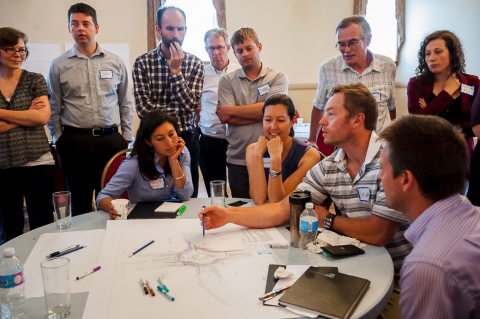
June 27th workshop review: "Re-Think Living Streets: Data, Design and Protected Intersections"
You are here
On Monday, June 27th, Miovision and Mobycon held a workshop dubbed “Re-Think Living Streets: Data, Design, and Protected Intersections.” Miovision is a company that specializes in the collection and processing of traffic data, and Mobycon is a transport and mobility consultancy founded in the Netherlands by Johan Diepens. These two companies work together on many projects, and decided to hold this workshop for interested parties, discussing the design of protected intersections and roundabouts. I was presented with the opportunity to attend, and as an ambitious engineering student, you can bet that I jumped all over it.
When I got there, I was happy to hear that about half of the attendees were from the City of Ottawa, which was great because it plants the ideas we were going to learn in the roots of city operations.
Johan gave a lecture on what Mobycon’s vision is, and how they achieve it. They desire liveable cities and child friendly cities. With a changing world comes change in transportation and mobility types, so different areas in a city need to be connected with smart transportation. A major factor in their design of intersections is allowing for at least 90° vision when people approach each other so that they can see each other and communicate if they need to. They place emphasis on differentiating areas for different types of transportations by elevating them, isolating them with elevated protection, using different materials and colours, etc. As many people know, the Netherlands have a much greater percentage of their population on bikes, and as such, they have developed very efficient ways of integrating cycling into their vehicle roads with minimal disadvantages to each.
A protected intersection is one that features physical separation of bikes and vehicles. This is achieved with barriers such as raised islands in the corners that truly separate cyclists from drivers. The separation also gives more space and time for commuters to see each other communicate if need be. These intersections often also feature many safe zones for drivers to sit in while waiting for cyclists, without interfering with the rest of the intersection.
A roundabout is a familiar concept, but Mobycon’s feature bike lanes that avoid the entire thing by going around and crossing the roads around the roundabout. This prevents and dangerous merging of vehicles and cyclists, and retains the high functionality of the roundabout. A turbo roundabout is much more intricate iteration of the typical roundabout. It is usually elevated from normal traffic grade to allow bikes and pedestrians to pass underneath due to the much higher volume of vehicle traffic that goes in and out of these roundabouts. Each road going in and out has multiple lanes feeding into it, and you choose which lane based on which exist you wish to take. Changing lanes in a turbo intersection is not allowed and prevented by barriers so that flow remains smooth.
A punaise is a design that is reserved for very small intersections with low traffic volumes. It is simply a circular area connecting all the streets, but the circular area features a relatively steep grade toward the center which forces drivers to think about what they are doing and slow down due to the uncomfortable orientation the car is in.
The day’s main workshop element was to redesign some existing intersections in the ward. The first was Byron/Kirkwood, in which all the groups took inspiration from protected intersections, and came up with similar designs. The second intersection was Carling/Kirkwood, which accommodates much more traffic. Most of the groups came up with similar designs as the first one, but one group (ours) came up with something completely different: we designed a modified turbo roundabout for this intersection, accommodating for every possible action that drivers and cyclists may make, and for the fire station on one of the corners. It took a while to refine the design, but it was fully functioning.
Since the session was held in Westboro, we looked at two local intersections in the ward, and how they could be improved: Fairmont/Duhamel, and Byron/Churchill. We were divided into four groups, and we each worked on the good aspects and the bad aspects of these intersections. Some of the suggested actions for these intersections were to add bike boxes to Byron/Churchill, and turn Fairmont/Duhamel into a roundabout.
In conclusion, it was a very informative and eye-opening session, which introduced new ideas with increasing applications in our city. As the people of Ottawa choose different and more diverse modes of transportation and mobility types, the need to integrate them will become more important and relevant to keep the city moving smoothly and happily. The concepts shown to us at this workshop are incredible examples of how we can move forward in the way we design city connecting intersections.
John “the intern” Paul Thomson
- Log in to post comments

